AI Research
How to Use AI Tools for Personal Productivity in 2025
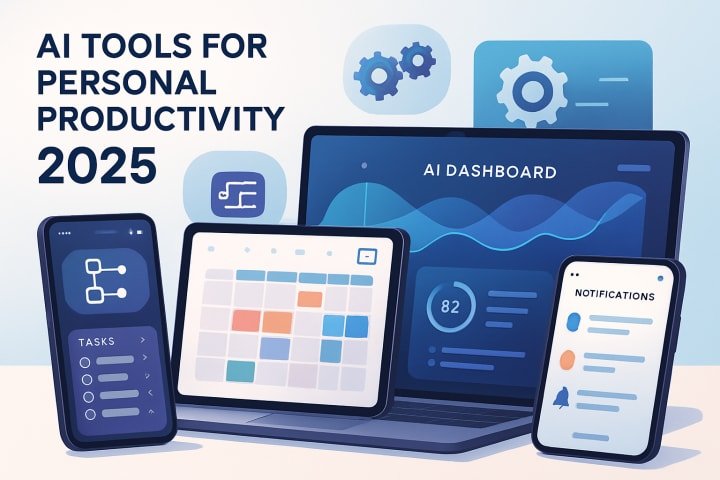
Artificial intelligence is no longer just a futuristic buzzword—it’s part of everyday life. From scheduling meetings to summarizing research papers, AI tools in 2025 have become powerful assistants that help people save time and work smarter. If you’ve ever felt overwhelmed with endless tasks, learning how to use AI tools for personal productivity could be a game-changer.
Why AI Matters for Productivity Today
AI tools are designed to simplify repetitive work, provide quick insights, and boost focus. Instead of juggling apps and wasting hours on small tasks, you can delegate much of the “busy work” to AI. That means more time for creative thinking, problem-solving, or simply enjoying life outside of work.
In 2025, AI tools are smarter and more accessible than ever. Many are built into devices you already use—your email, calendar, browser, or smartphone. With the right approach, you can turn them into a personal productivity system that feels almost like having a digital assistant.
Top Areas Where AI Boosts Personal Productivity
1. Task Management and Planning
AI-powered to-do list apps don’t just record tasks—they prioritize them. Apps like Motion, Todoist with AI, or Notion AI can automatically schedule tasks based on your deadlines, habits, and energy levels.
For example:
You add “Finish presentation” to your list.
The AI looks at your calendar, finds a two-hour free slot, and schedules it automatically.
This removes the mental load of planning and helps you stay consistent.
2. Writing and Communication
One of the most popular uses of AI is improving writing. Tools like ChatGPT, Jasper, or Grammarly Go can:
Draft emails in your tone.
Summarize long documents into quick highlights.
Generate creative ideas for blog posts or reports.
Instead of spending 30 minutes writing a message, you might spend just five reviewing what the AI suggests. That’s a huge time-saver, especially if communication is a big part of your day.
3. Learning and Research
Need understand a new topic quickly? AI research assistants like Perplexity AI or Scholarcy can scan sources, summarize key points, and even suggest follow-up reading. This turns hours of manual searching into a 10-minute process.
Students and professionals use these tools for:
Summarizing research papers.
Breaking down complex topics.
Generating flashcards for study.
By using AI, you can cut through information overload and focus on what matters.
4. Meeting and Calendar Management
AI scheduling assistants like Reclaim or Calendly AI analyze your habits and preferences to suggest meeting times automatically. They even learn when you’re most productive and block time for deep work.
Plus, transcription tools like Otter.ai or Fireflies.ai now not only record meetings but also summarize key action points. Instead of rewatching an hour-long Zoom recording, you get a one-page summary in seconds.
5. Personal Health and Focus
Productivity isn’t just about getting more done—it’s also about staying healthy. AI-powered wellness apps like Headspace AI Coach or Fitbit’s AI tracker can monitor your stress, suggest meditation, or remind you to take breaks.
Imagine your AI assistant noticing you’ve been on Zoom calls all morning. It nudges you to step outside for a 10-minute walk to recharge. These small interventions can make your workday more balanced.
How to Integrate AI Into Your Daily Workflow
Start Small
Pick one task you often struggle with—maybe scheduling, note-taking, or drafting emails. Introduce an AI tool just for that. Once you’re comfortable, expand into other areas.
Stay in Control
Remember, AI should support you, not control you. Always review outputs like meeting notes or emails before sending. Think of AI as a co-pilot—you’re still the pilot.
Automate Repetitive Work
Look at tasks you repeat daily: responding to routine emails, generating reports, setting reminders. These are perfect candidates for automation. The more repetitive the task, the more value AI brings.
Balance Efficiency with Privacy
Many AI tools rely on data. Always check privacy settings and choose tools that respect your information. Productivity should never come at the cost of security.
Common Mistakes to Avoid
Relying Completely on AI – It’s tempting to let AI do everything, but human judgment is still crucial.
Using Too Many Tools – Stick to a handful of apps. Switching between ten AI tools can create more chaos than clarity.
Skipping Review – AI outputs can be wrong or biased. Always double-check before sharing.
Ignoring Learning Curve – AI tools are powerful, but they require practice. Give yourself time to adapt.
Examples of AI Productivity Workflows
Morning routine: AI summarizes overnight emails and news into a short daily digest.
During work: AI blocks distractions, schedules focus time, and takes meeting notes.
After work: AI tracks your activity and suggests a quick workout or relaxation session.
By combining small actions, AI tools create a seamless system that supports productivity from morning to night.
The Future of AI Productivity in 2025 and Beyond
AI will continue moving from being a separate tool to an invisible assistant embedded in everything we use. Imagine:
Your laptop suggesting when to close for the day.
Your calendar automatically rescheduling low-priority meetings if you’re overwhelmed.
Your phone coaching you through stress before an important presentation.
The key is to treat AI as a partner, not a replacement. The people who benefit most are not those who use AI the most, but those who use it wisely.
Conclusion
Learning how to use AI tools for personal productivity in 2025 isn’t about working harder—it’s about working smarter. Whether it’s automating your calendar, summarizing long reports, or helping you focus, AI can take care of the small things so you can focus on the big picture.
The best part? You don’t need to be a tech expert. With a little curiosity and the right tools, anyone can turn AI into their personal productivity assistant.
So, which area will you start with—scheduling, writing, or learning? Share your thoughts in the comments and let’s explore how AI can make 2025 your most productive year yet.
Discover how to use AI tools for personal productivity in 2025. Save time, stay organized, and work smarter with the best AI apps and strategies.
Boost your productivity in 2025 with AI tools. Learn how to manage tasks, automate work, and focus better using smart technology.
Find out how AI tools for personal productivity can transform your daily workflow in 2025. Practical tips and examples inside.
Maximize efficiency in 2025 by using AI for scheduling, writing, and learning. A practical guide to AI-powered personal productivity.
Learn how to work smarter, not harder. This guide explains how AI tools improve personal productivity in 2025 with real-world examples.
AI Research
Lessons from 60 Years in Journalism — A Postscript on Artificial Intelligence – TAPinto
AI Research
Tories pledge to get ‘all our oil and gas out of the North Sea’

Conservative leader Kemi Badenoch has said her party will remove all net zero requirements on oil and gas companies drilling in the North Sea if elected.
Badenoch is to formally announce the plan to focus solely on “maximising extraction” and to get “all our oil and gas out of the North Sea” in a speech in Aberdeen on Tuesday.
Reform UK has said it wants more fossil fuels extracted from the North Sea.
The Labour government has committed to banning new exploration licences. A spokesperson said a “fair and orderly transition” away from oil and gas would “drive growth”.
Exploring new fields would “not take a penny off bills” or improve energy security and would “only accelerate the worsening climate crisis”, the government spokesperson warned.
Badenoch signalled a significant change in Conservative climate policy when she announced earlier this year that reaching net zero would be “impossible” by 2050.
Successive UK governments have pledged to reach the target by 2050 and it was written into law by Theresa May in 2019. It means the UK must cut carbon emissions until it removes as much as it produces, in line with the 2015 Paris Climate Agreement.
Now Badenoch has said that requirements to work towards net zero are a burden on oil and gas producers in the North Sea which are damaging the economy and which she would remove.
The Tory leader said a Conservative government would scrap the need to reduce emissions or to work on technologies such as carbon storage.
Badenoch said it was “absurd” the UK was leaving “vital resources untapped” while “neighbours like Norway extracted them from the same sea bed”.
In 2023, then Prime Minister Rishi Sunak granted 100 new licences to drill in the North Sea which he said at the time was “entirely consistent” with net zero commitments.
Reform UK has said it will abolish the push for net zero if elected.
The current government said it had made the “biggest ever investment in offshore wind and three first of a kind carbon capture and storage clusters”.
Carbon capture and storage facilities aim to prevent carbon dioxide (CO2) produced from industrial processes and power stations from being released into the atmosphere.
Most of the CO2 produced is captured, transported and then stored deep underground.
It is seen by the likes of the International Energy Agency and the Climate Change Committee as a key element in meeting targets to cut the greenhouse gases driving dangerous climate change.
AI Research
Dogs and drones join forest battle against eight-toothed beetle

Esme Stallard and Justin RowlattClimate and science team
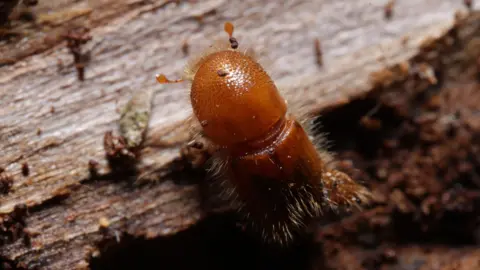 Sean Gallup/Getty Images
Sean Gallup/Getty ImagesIt is smaller than your fingernail, but this hairy beetle is one of the biggest single threats to the UK’s forests.
The bark beetle has been the scourge of Europe, killing millions of spruce trees, yet the government thought it could halt its spread to the UK by checking imported wood products at ports.
But this was not their entry route of choice – they were being carried on winds straight over the English Channel.
Now, UK government scientists have been fighting back, with an unusual arsenal including sniffer dogs, drones and nuclear waste models.
They claim the UK has eradicated the beetle from at risk areas in the east and south east. But climate change could make the job even harder in the future.
The spruce bark beetle, or Ips typographus, has been munching its way through the conifer trees of Europe for decades, leaving behind a trail of destruction.
The beetles rear and feed their young under the bark of spruce trees in complex webs of interweaving tunnels called galleries.
When trees are infested with a few thousand beetles they can cope, using resin to flush the beetles out.
But for a stressed tree its natural defences are reduced and the beetles start to multiply.
“Their populations can build to a point where they can overcome the tree defences – there are millions, billions of beetles,” explained Dr Max Blake, head of tree health at the UK government-funded Forestry Research.
“There are so many the tree cannot deal with them, particularly when it is dry, they don’t have the resin pressure to flush the galleries.”
Since the beetle took hold in Norway over a decade ago it has been able to wipe out 100 million cubic metres of spruce, according to Rothamsted Research.
‘Public enemy number one’
As Sitka spruce is the main tree used for timber in the UK, Dr Blake and his colleagues watched developments on continental Europe with some serious concern.
“We have 725,000 hectares of spruce alone, if this beetle was allowed to get hold of that, the destructive potential means a vast amount of that is at risk,” said Andrea Deol at Forestry Research. “We valued it – and it’s a partial valuation at £2.9bn per year in Great Britain.”
There are more than 1,400 pests and diseases on the government’s plant health risk register, but Ips has been labelled “public enemy number one”.
The number of those diseases has been accelerating, according to Nick Phillips at charity The Woodland Trust.
“Predominantly, the reason for that is global trade, we’re importing wood products, trees for planting, which does sometimes bring ‘hitchhikers’ in terms of pests and disease,” he said.
Forestry Research had been working with border control for years to check such products for Ips, but in 2018 made a shocking discovery in a wood in Kent.
“We found a breeding population that had been there for a few years,” explained Ms Deol.
“Later we started to pick up larger volumes of beetles in [our] traps which seemed to suggest they were arriving by other means. All of the research we have done now has indicated they are being blown over from the continent on the wind,” she added.
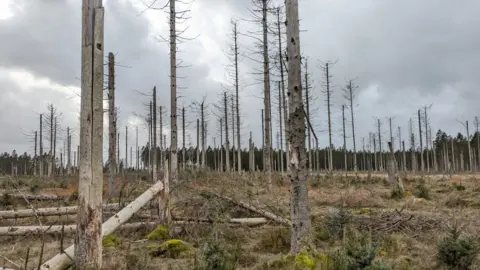 Daegan Inward/Forestry Research
Daegan Inward/Forestry ResearchThe team knew they had to act quickly and has been deploying a mixture of techniques that wouldn’t look out of place in a military operation.
Drones are sent up to survey hundreds of hectares of forest, looking for signs of infestation from the sky – as the beetle takes hold, the upper canopy of the tree cannot be fed nutrients and water, and begins to die off.
But next is the painstaking work of entomologists going on foot to inspect the trees themselves.
“They are looking for a needle in a haystack, sometimes looking for single beetles – to get hold of the pioneer species before they are allowed to establish,” Andrea Deol said.
In a single year her team have inspected 4,500 hectares of spruce on the public estate – just shy of 7,000 football pitches.
Such physically-demanding work is difficult to sustain and the team has been looking for some assistance from the natural and tech world alike.
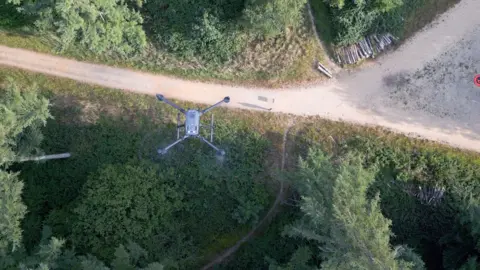 Tony Jolliffe/BBC
Tony Jolliffe/BBCWhen the pioneer Spruce bark beetles find a suitable host tree they release pheromones – chemical signals to attract fellow beetles and establish a colony.
But it is this strong smell, as well as the smell associated with their insect poo – frass – that makes them ideal to be found by sniffer dogs.
Early trials so far have been successful. The dogs are particularly useful for inspecting large timber stacks which can be difficult to inspect visually.
The team is also deploying cameras on their bug traps, which are now able to scan daily for the beetles and identify them in real time.
“We have [created] our own algorithm to identify the insects. We have taken about 20,000 images of Ips, other beetles and debris, which have been formally identified by entomologists, and fed it into the model,” said Dr Blake.
Some of the traps can be in difficult to access areas and previously had only been checked every week by entomologists working on the ground.
The result of this work means that the UK has been confirmed as the first country to have eradicated Ips Typographus in its controlled areas, deemed to be at risk from infestation, and which covers the south east and east England.
“What we are doing is having a positive impact and it is vital that we continue to maintain that effort, if we let our guard down we know we have got those incursion risks year on year,” said Ms Deol.
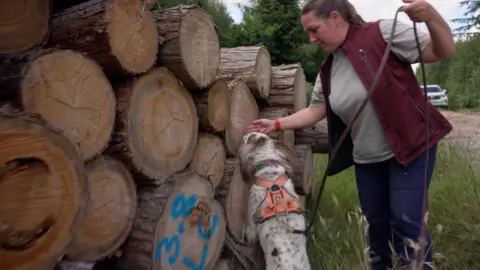 Tony Jolliffe/BBC
Tony Jolliffe/BBCAnd those risks are rising. Europe has seen populations of Ips increase as they take advantage of trees stressed by the changing climate.
Europe is experiencing more extreme rainfall in winter and milder temperatures meaning there is less freezing, leaving the trees in waterlogged conditions.
This coupled with drier summers leaves them stressed and susceptible to falling in stormy weather, and this is when Ips can take hold.
With larger populations in Europe the risk of Ips colonies being carried to the UK goes up.
The team at Forestry Research has been working hard to accurately predict when these incursions may occur.
“We have been doing modelling with colleagues at the University of Cambridge and the Met Office which have adapted a nuclear atmospheric dispersion model to Ips,” explained Dr Blake. “So, [the model] was originally used to look at nuclear fallout and where the winds take it, instead we are using the model to look at how far Ips goes.”
Nick Phillips at The Woodland Trust is strongly supportive of the government’s work but worries about the loss of ancient woodland – the oldest and most biologically-rich areas of forest.
Commercial spruce have long been planted next to such woods, and every time a tree hosting spruce beetle is found, it and neighbouring, sometimes ancient trees, have to be removed.
“We really want the government to maintain as much of the trees as they can, particularly the ones that aren’t affected, and then also when the trees are removed, supporting landowners to take steps to restore what’s there,” he said. “So that they’re given grants, for example, to be able to recover the woodland sites.”
The government has increased funding for woodlands in recent years but this has been focused on planting new trees.
“If we only have funding and support for the first few years of a tree’s life, but not for those woodlands that are 100 or century years old, then we’re not going to be able to deliver nature recovery and capture carbon,” he said.
Additional reporting Miho Tanaka

-
Tools & Platforms3 weeks ago
Building Trust in Military AI Starts with Opening the Black Box – War on the Rocks
-

 Ethics & Policy1 month ago
Ethics & Policy1 month agoSDAIA Supports Saudi Arabia’s Leadership in Shaping Global AI Ethics, Policy, and Research – وكالة الأنباء السعودية
-

 Events & Conferences3 months ago
Events & Conferences3 months agoJourney to 1000 models: Scaling Instagram’s recommendation system
-

 Business2 days ago
Business2 days agoThe Guardian view on Trump and the Fed: independence is no substitute for accountability | Editorial
-

 Jobs & Careers2 months ago
Jobs & Careers2 months agoMumbai-based Perplexity Alternative Has 60k+ Users Without Funding
-

 Funding & Business2 months ago
Funding & Business2 months agoKayak and Expedia race to build AI travel agents that turn social posts into itineraries
-

 Education2 months ago
Education2 months agoVEX Robotics launches AI-powered classroom robotics system
-

 Podcasts & Talks2 months ago
Podcasts & Talks2 months agoHappy 4th of July! 🎆 Made with Veo 3 in Gemini
-

 Podcasts & Talks2 months ago
Podcasts & Talks2 months agoOpenAI 🤝 @teamganassi
-

 Jobs & Careers2 months ago
Jobs & Careers2 months agoAstrophel Aerospace Raises ₹6.84 Crore to Build Reusable Launch Vehicle





















